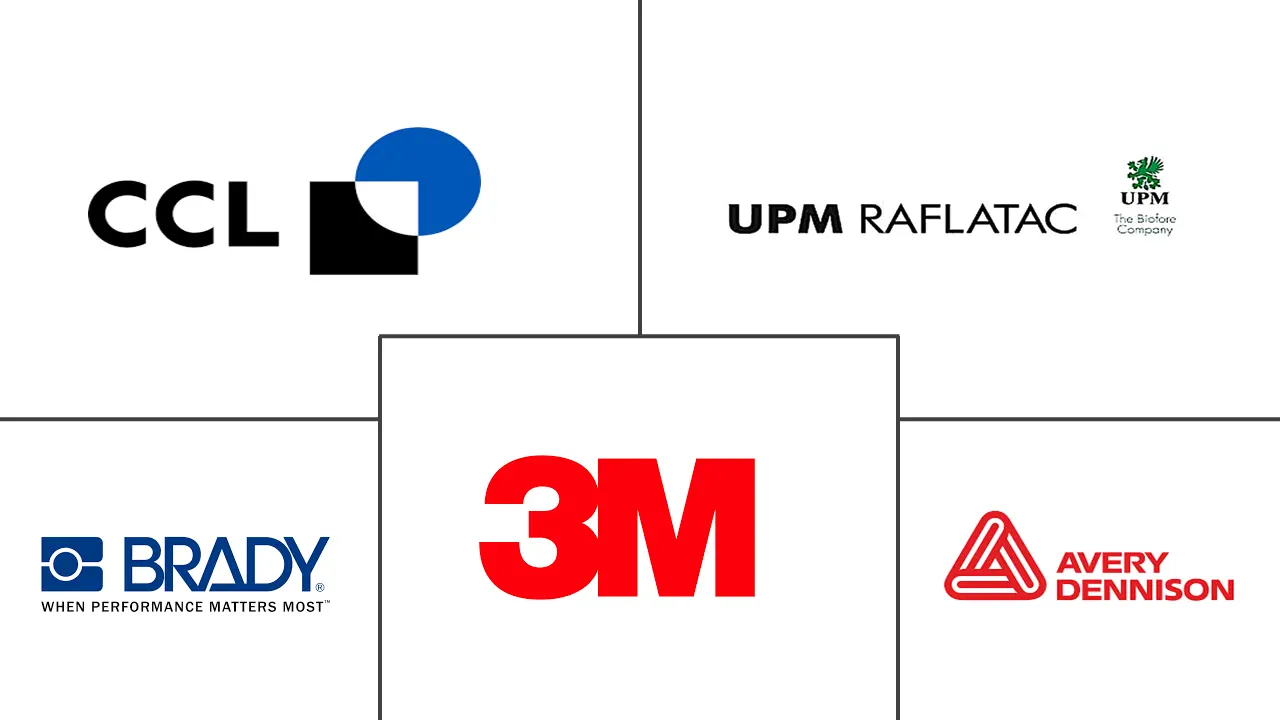Industrial Labels Market Size and Share
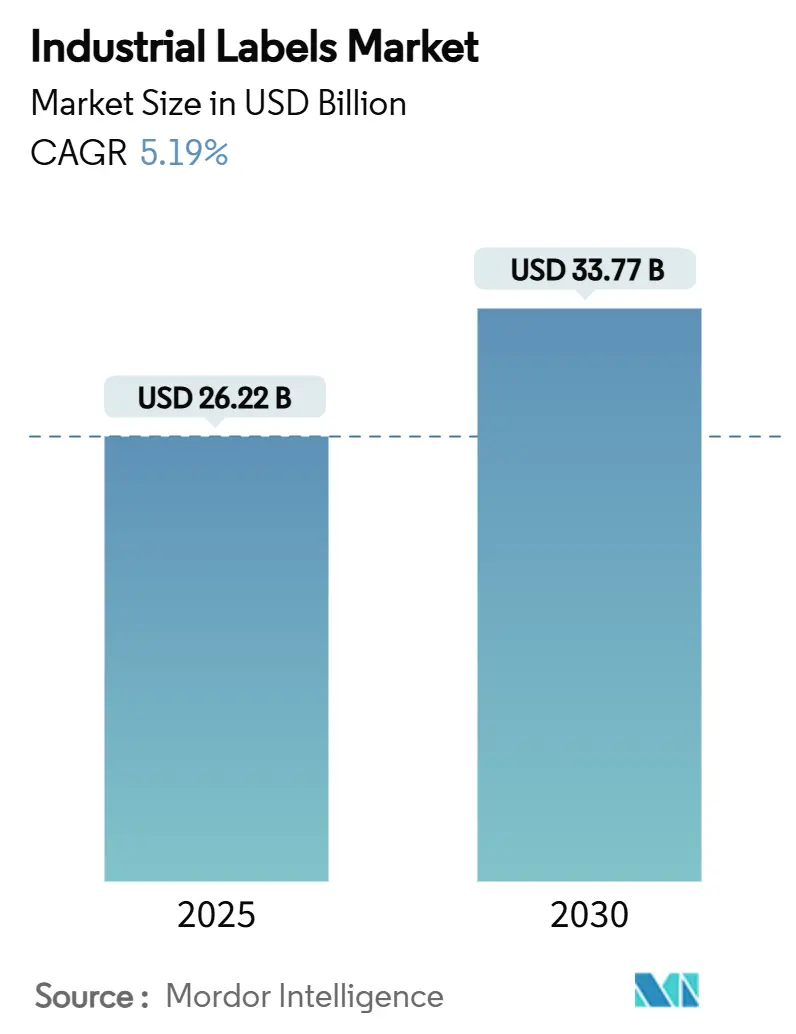
Industrial Labels Market Analysis by Mordor Intelligence
The industrial labels market size is valued at USD 26.22 billion in 2025 and is forecast to reach USD 33.77 billion by 2030, registering a 5.19% CAGR during 2025-2030. This growth momentum underscores sustained demand for reliable product identification, traceability, and safety communication as regulations tighten and digital manufacturing expands. New compliance mandates, rapid e-commerce fulfillment, and accelerating adoption of digital and smart printing technologies are reshaping cost structures and competitive strategies across converters, raw-material suppliers, and equipment manufacturers. The industrial labels market benefits from rising investment in factory automation and logistics visibility, yet pricing volatility for polymers and adhesives and stricter VOC limits continue to pressure margins. Overall, the sector demonstrates a balanced mix of mature end-use demand and emerging innovation pockets that collectively support mid-single-digit growth over the next five years.
Key Report Takeaways
- By raw material, polymer/plastic labels commanded 52.43% share of industrial labels market size in 2024, whereas paper-based eco substrates are advancing at a 9.54% CAGR to 2030.
- By mechanism, pressure-sensitive formats led with 43.42% industrial labels market share in 2024; in-mold and heat-transfer systems are forecast to grow at 8.95% CAGR.
- By product type, branding and promotional labels accounted for 30.32% of industrial labels market size in 2024, with track-and-trace smart labels progressing at 9.25% CAGR.
- By identification technology, barcodes retained 58.23% share of industrial labels market size in 2024, while RFID is the fastest mover at a 9.21% CAGR.
- By end-user industry, food and beverage controlled 22.54% of industrial labels market share in 2024, whereas logistics and warehousing is rising at 9.98% CAGR through 2030.
- By geography, Asia-Pacific held 38.32% of industrial labels market share in 2024, while the region is projected to expand at 8.67% CAGR through 2030.
Global Industrial Labels Market Trends and Insights
Drivers Impact Analysis
| Driver | (~) % Impact on CAGR Forecast | Geographic Relevance | Impact Timeline |
|---|---|---|---|
| Food & beverage compliance labeling demand | +1.2% | North America, EU, globally scaling | Medium term (2-4 years) |
| E-commerce and logistics label growth | +0.9% | APAC, North America | Short term (≤ 2 years) |
| Digital and hybrid printing adoption | +0.8% | Developed markets | Medium term (2-4 years) |
| Traceability and safety regulations | +0.7% | North America, EU, APAC migration | Long term (≥ 4 years) |
| Industry 4.0 smart label integration | +0.6% | Developed markets, gradual APAC uptake | Long term (≥ 4 years) |
| Hybrid printing for mass customization | +0.5% | North America, EU, emerging APAC | Medium term (2-4 years) |
| Source: Mordor Intelligence | |||
Rising demand from food and beverage compliance labelling
Manufacturers face imminent January 2026 enforcement of the FDA Food Traceability Rule, forcing adoption of labels capable of carrying 2D codes and serialized Traceability Lot Codes.[1]U.S. Food and Drug Administration, “FSMA Final Rule on Traceability,” fda.govUniform compliance dates set for new food labeling rules in 2028 heighten the need for print systems that flex with evolving data fields. Demand is rising for durable, weather-resistant substrates that stay legible across cold chains. The push toward 2D barcodes is increasing printer resolution requirements, and early retail pilots with RFID-embedded bakery labels illustrate how compliance intersects with supply-chain optimization. As brands retrofit lines, the industrial labels market records a surge in high-specification food-grade products.
Accelerating e-commerce and logistics labelling growth
Automated fulfillment centers are scaling variable-data labels that originate in ERP systems and travel through robotics-driven warehouses, aligning with a 9.98% CAGR in logistics labeling. Walmart’s expanded RFID directive compels upstream suppliers to embed encoded inlays at item level. Real-time location sensing printed BLE labels show how IoT-ready tags are replacing passive barcodes to meet AI-powered inventory algorithms. APAC’s booming cross-border e-commerce further accelerates industrial labels market demand for machine-readable, error-free identification.
Rapid adoption of digital and hybrid printing technologies
Digital printing’s 7.98% CAGR reflects converter migration toward shorter runs and late-stage customization. Platforms such as HP Indigo V12 reach 120 m/min and substitute multiple flexo presses for serialized output . Hybrid architectures merge inkjet heads with flexo stations, giving converters cost-optimized production flexibility. Cloud-connected printers like Epson CW-C8000 simplify decentralized manufacturing models by remote job queues. Sustainability benefits—lower make-ready waste and on-demand output—reinforce adoption across pharma, chemicals, and specialty foods, strengthening the industrial labels market outlook.
Regulatory mandates for traceability and safety
Pharmaceutical lines must serialize every saleable package for November 2024 DSCSA enforcement, creating durable labels that encode GTIN, serial, lot, and expiry data. OSHA’s GHS Revision 7 alignment forces chemical makers to redesign 64% of shipping labels by 2026. Unique Device Identification and emerging EV battery passports further expand serialization scope. These overlapping mandates extend purchase cycles for premium substrates, inks, and security features, supporting sustained industrial labels market growth.
Restraints Impact Analysis
| Restraint | (~) % Impact on CAGR Forecast | Geographic Relevance | Impact Timeline |
|---|---|---|---|
| Volatile raw-material and adhesive pricing | -0.8% | Global, acute APAC manufacturing | Short term (≤ 2 years) |
| Stringent environmental regulations on plastics & VOCs | -0.6% | EU, North America, global adoption | Medium term (2-4 years) |
| Skilled-labour shortage in digital colour management | -0.4% | North America, EU | Medium term (2-4 years) |
| Supply-chain disruptions for specialty inks & liners | -0.3% | Global, regional variation | Short term (≤ 2 years) |
| Source: Mordor Intelligence | |||
Volatile raw-material and adhesive pricing
Downward swings in polyvinyl alcohol costs, interspersed with freight surcharges, hamper profit planning in Asia-Pacific converting hubs. Contract renegotiations become frequent as adhesive feedstocks and silicone liners move sharply with oil and energy markets. Q4 2024 sourcing reports flag erratic availability of specialty coatings, prompting converters to hold buffer inventories that erode working capital. Combined, these shocks slightly temper overall industrial labels market expansion despite healthy demand.
Stringent environmental regulations on plastics and VOCs
EPA aerosol-coating rules and California VOC caps press formulators to reformulate inks and adhesives at higher R&D costs. EU packaging directives tighten recycled-content quotas, accelerating the transition to paper and compostable films that may not match polymer durability in heavy-duty applications. Canadian VOC thresholds add multi-jurisdictional complexity. Compliance costs can delay capital spending, trimming near-term industrial labels market gains.
Segment Analysis
By Raw Material: Sustainability Drives Innovation
Polymer labels retained 52.43% industrial labels market share in 2024 due to superior chemical resistance, yet paper-based eco substrates are set to outpace with a 9.54% CAGR, lifting their slice of industrial labels market size through 2030. Automotive, agrochemical, and lubricants applications still rely on PP and PET films for abrasion resistance, while hybrid laminates combine metal and polymer layers for extreme environments.
Sustainability imperatives are catalyzing rapid material substitution. Carbon-action paper lines and hemp-fiber label stocks demonstrate measurable footprint reductions.[2]UPM Raflatac, “Carbon Action Label Portfolio,” upmraflatac.com Fruit-waste and nut-shell papers repurpose agricultural by-products, appealing to premium food brands. Early adopters differentiate by reporting cradle-to-gate emissions in quotations, a first in the industrial labels market.
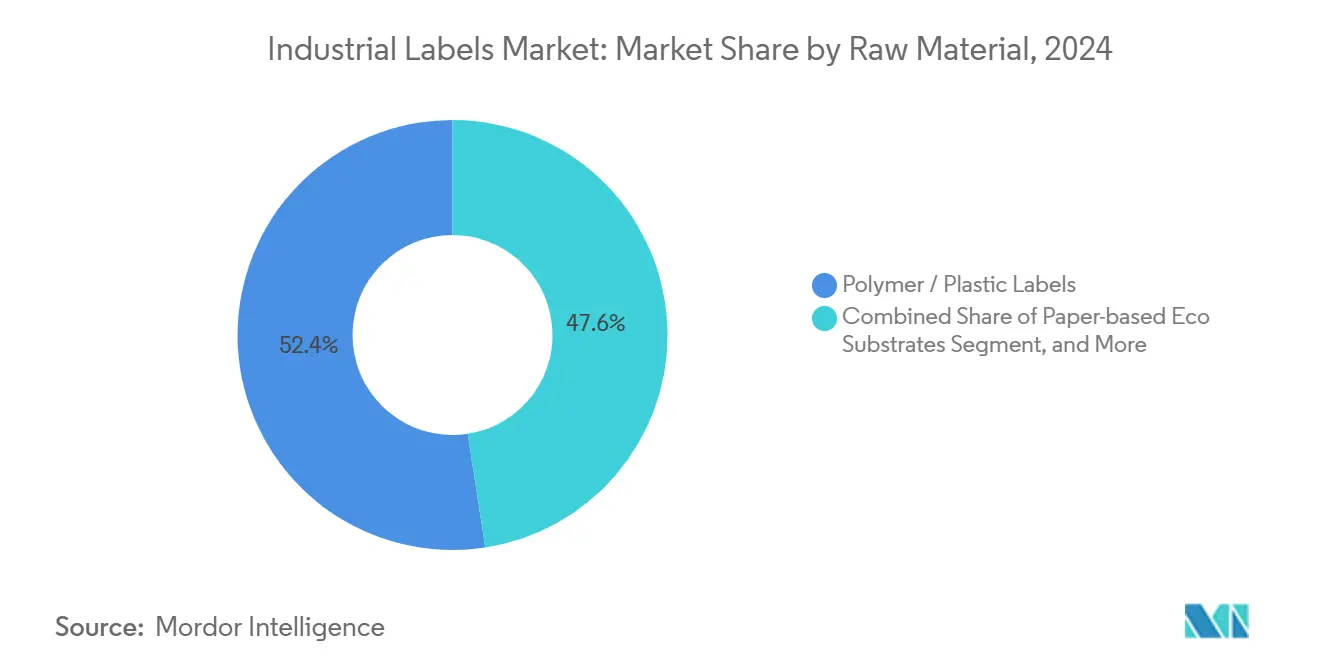
Note: Segment shares of all individual segments available upon report purchase
By Mechanism: Automation Reshapes Application Methods
Pressure-sensitive constructions led with 43.42% industrial labels market share in 2024 on the strength of fast, flexible application lines across FMCG and pharma plants. Concurrently, in-mold and heat-transfer labels present an 8.95% CAGR as blow-molders and injection molders integrate decoration into primary forming.
Linerless technology illustrates dual gains in productivity and sustainability, providing 80% more labels per roll and reducing downtime. OptiCut WashOff linerless labels detach cleanly in recycling baths, aiding closed-loop PET systems. Robotics-ready applicators further integrate these mechanisms into Industry 4.0 lines, enhancing industrial labels market adoption.
By Product Type: Intelligence Transforms Functionality
Branding and promotional formats held 30.32% of industrial labels market size in 2024, but smart labels integrating RFID, NFC, or BLE are rising fastest at 9.25% CAGR. Warning labels remain mandatory in chemicals and heavy machinery, while durable rating plates withstand UV, oil, and abrasion.
Battery-free smart labels using printed photovoltaics unlock long-life asset tracking without periodic battery replacement. Cold-chain e-paper indicators visually flag temperature breaches. Such innovations push the industrial labels market beyond static information toward active supply-chain intelligence.
By Printing Technology: Digital Revolution Accelerates
Analog processes still produced 55.23% of industrial labels market output in 2024, yet digital presses are scaling at a 7.98% CAGR as converters pursue SKU proliferation economics. Hybrid lines capture the sweet spot where static colors meet variable data on a single pass.
Konica Minolta’s AccurioLabel 400 with inline densitometry delivers offset-comparable color. Flexible-pack converters add HP Indigo 200K units to service short-run pouches and sachets. Indian SMEs installing mid-range inkjet presses demonstrate how digital democratizes industrial labels market participation.
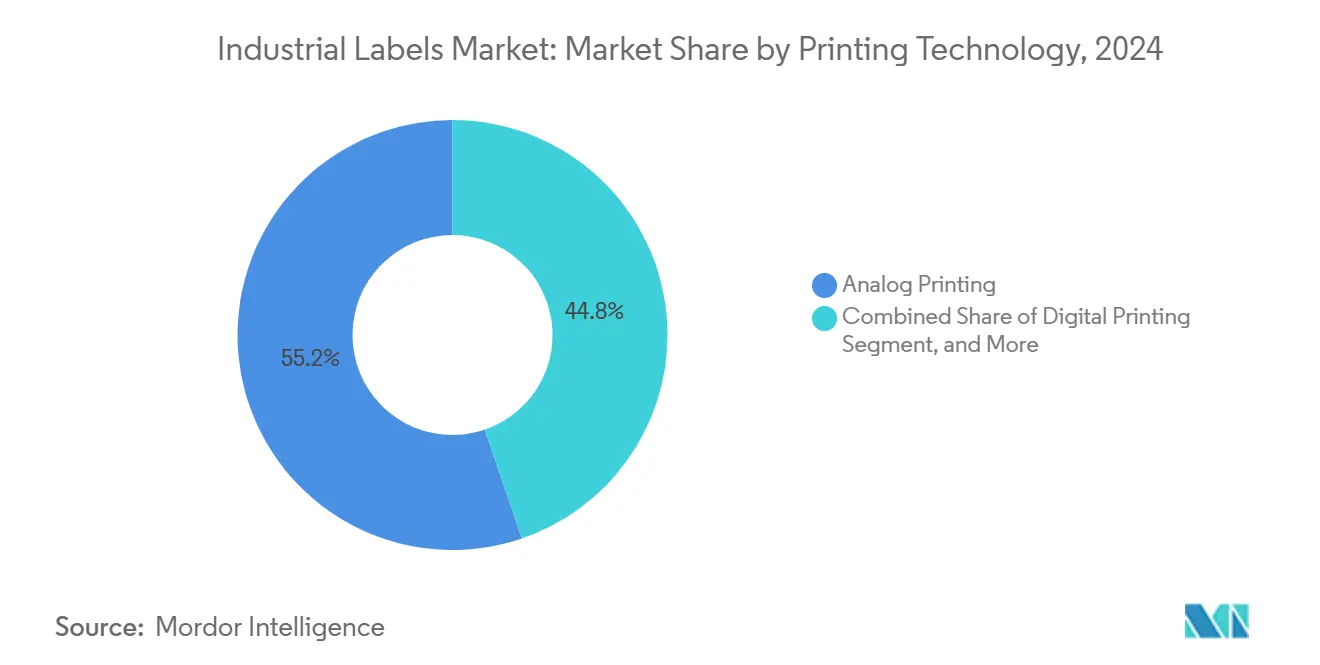
Note: Segment shares of all individual segments available upon report purchase
By Identification Technology: Smart Integration Expands
Barcodes retained 58.23% share in 2024, but RFID is accelerating at 9.21% CAGR as retailers widen mandates. NFC-enabled consumer engagement and data-rich QR codes cover interactive marketing niches.
Avery Dennison’s USD 100 million RFID hub in Mexico adds billions of inlays for North American supply chains. Retailers deploying RFID report <2% shrinkage and double-digit labor savings. These outcomes reinforce adoption, bolstering industrial labels market revenue streams tied to intelligent identification.
By End-user Industry: Diversification Drives Growth
Food and beverage accounted for 22.54% industrial labels market share in 2024 as allergen and origin rules multiplied label SKUs. Logistics and warehousing show the fastest 9.98% CAGR, powered by omnichannel retail and autonomous fulfillment.
Healthcare serialization under DSCSA sustains premium demand, while EV battery tracking solutions open new automotive revenue pools. Heavy-equipment OEMs bolster safety features with high-visibility durability labels. This industry spread reduces concentration risk and expands total industrial labels market addressability.
Geography Analysis
Asia-Pacific dominated with 38.32% industrial labels market share in 2024 and is projected to compound at 8.67% through 2030 thanks to expanding electronics, automotive, and e-commerce hubs. China and India spearhead capacity additions, while ASEAN incentives attract near-shoring. Government Industry 4.0 programs accelerate smart-label adoption inside new greenfield plants, cementing the region’s pivotal role in global industrial labels market growth.
North America benefits from entrenched regulatory frameworks and big-box retail mandates. Avery Dennison’s Querétaro RFID plant underscores Mexico’s ascent as a low-cost supply partner for U.S. converters Averydennison. Canadian VOC controls and the U.S. emphasis on supply-chain security keep label demand resilient across consumer and strategic industries, reinforcing regional industrial labels market stability.
Europe exhibits mature demand moderated by strict eco-design and waste directives. Recyclable label innovations enjoy early adoption as brand owners align with European Green Deal goals. Germany’s automation leadership sustains high-spec production tools, while UK regulatory divergence post-Brexit prompts multi-language, multi-format label strategies. Emerging clusters in the Middle East & Africa and South America show variable trajectories but remain attractive for converters seeking first-mover gains in developing industrial labels markets.
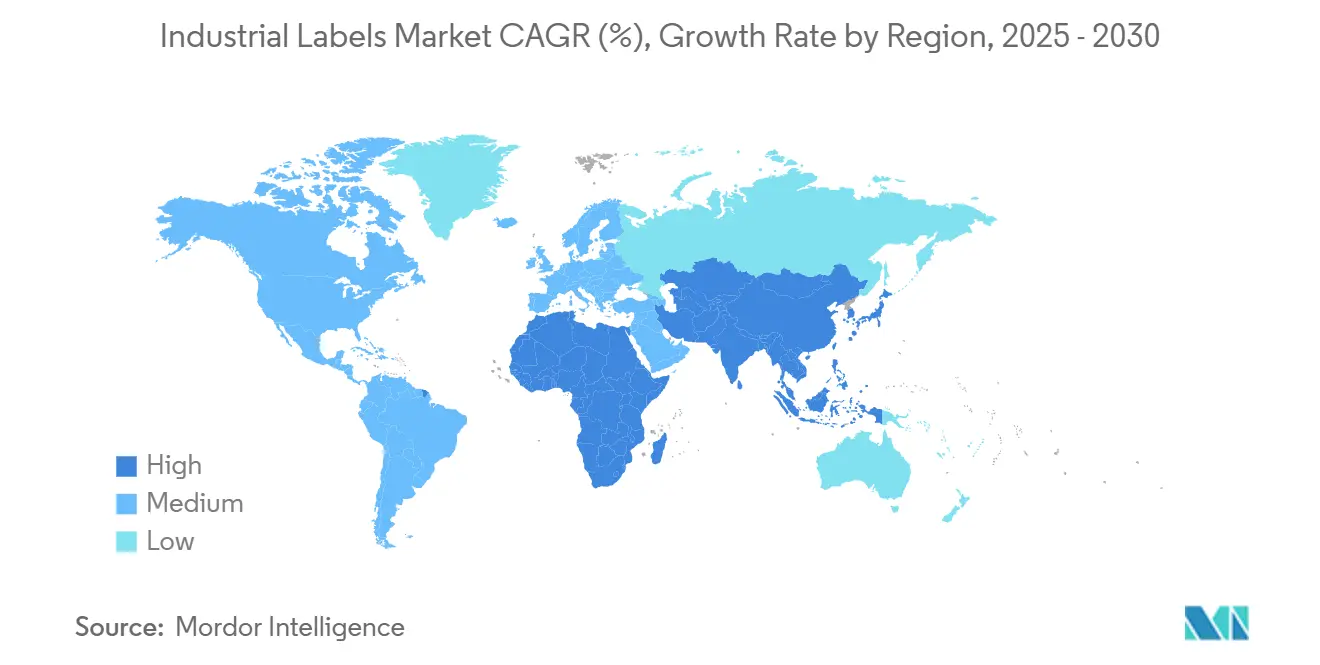
Competitive Landscape
The industrial labels market shows moderate concentration. Top players Avery Dennison, CCL Industries, and 3M collectively command significant share via global manufacturing networks and vertical integration. Their combined focus on intelligent labels, sustainable substrates, and turnkey print-apply systems fortifies barriers to entry.
However, digital printing erodes scale advantages, enabling regional converters to compete on agility and customization. Strategic differentiation now hinges on cloud workflow platforms and data-rich smart labels rather than raw press capacity. Avery Dennison reported USD 8.4 billion net sales in 2024, propelled by its Intelligent Labels division, evidencing the margin premium tied to RFID and analytics-driven offerings.[3]Avery Dennison, “2024 Investor Day Presentation,” q4cdn.com
M&A remains active as larger groups buy specialists to deepen technology stacks—ProMach’s Etiflex acquisition adds RFID expertise in Mexico. Private-equity capital fuels expansion of mid-tier converters that focus on pressure-sensitive and linerless niches. Continual innovation pressure is expected to sustain a fragmented long-tail of specialists, keeping overall industrial labels market rivalry dynamic.
Industrial Labels Industry Leaders
-
Avery Dennison Corporation
-
3M Company
-
Brady Corporation
-
CCL Industries Inc.
-
UPM RAFLATAC
- *Disclaimer: Major Players sorted in no particular order
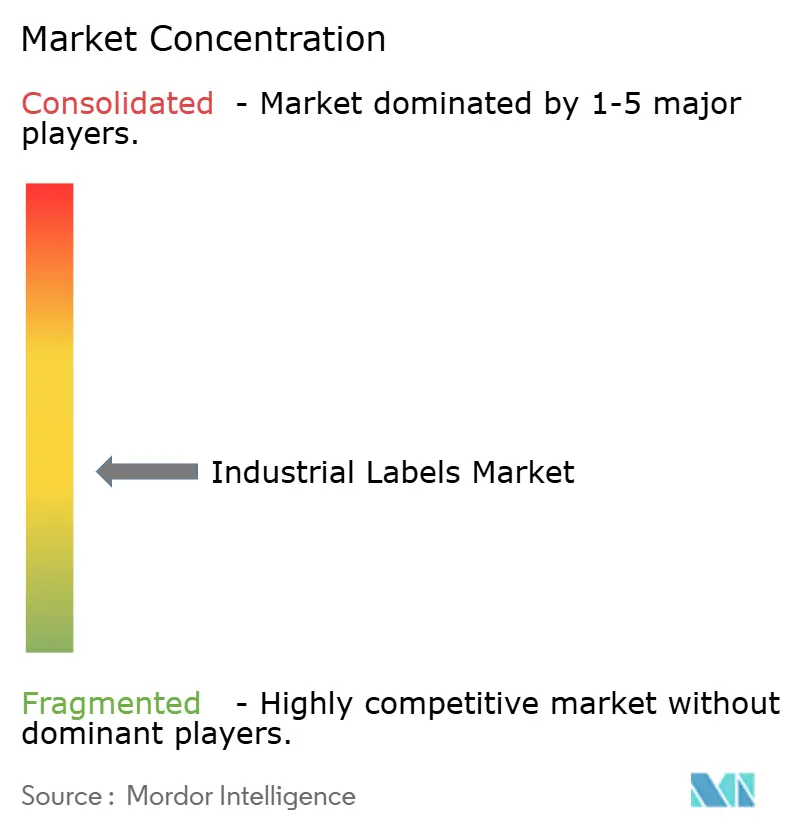
Recent Industry Developments
- May 2025: ProMach acquired DJS Systems to extend automation capabilities for disposable food packaging.
- May 2025: Specialty Printing secured USD 11.5 million to add 50 positions in grocery, medical, and logistics label lines.
- April 2025: UPM Raflatac began quoting product carbon footprints, a first for global label suppliers.
- March 2025: ProMach ID Technology acquired Etiflex, broadening its North American pressure-sensitive and RFID label offering.
Global Industrial Labels Market Report Scope
Industrial labels refer to materials used to mark equipment and provide visual or written information about the use of risks. It is durable and highly resistant to heat, light, moisture, caustic solvents, and other environmental factors that can cause labels to fade, crack, crack, or peel. Most industrial labeling applications require long-term readability on harsh physical devices.
The industrial labels market is segmented by raw material (metal labels and plastic/polymer labels), mechanism (pressure sensitive labeling and shrink sleeve labeling, and other mechanisms), product type (warning/security labels, branding labels, weatherproof labels, equipment asset tags, and other product types), printing technology (analog printing and digital printing), end-user industry (electronics industry, food & beverage, personal care, pharmaceuticals, and other end-user industry), and geography (North America (United States and Canada), Europe (United Kingdom, Germany, France, Spain, and rest of Europe), Asia Pacific (China, Japan, India, South Korea, Australia & New Zealand, rest of Asia Pacific), Latin America (Brazil, Mexico, Argentina, rest of Latin America), and Middle East and Africa (United Arab Emirates, Saudi Arabia, South Africa, and rest of Middle East and Africa)). The report offers market forecasts and size in value (USD) for all the above segments.
| Polymer / Plastic Labels |
| Metal Labels |
| Paper-based Eco Substrates |
| Hybrid Laminates and Others |
| Pressure-Sensitive Labeling |
| Glue-Applied Labeling |
| Shrink-Sleeve Labeling |
| In-Mold and Heat-Transfer Labeling |
| Liner-less Labeling |
| Warning / Security Labels |
| Asset and Inventory Tags |
| Branding and Promotional Labels |
| Weather-proof and Durable Labels |
| Track-and-Trace (Smart / RFID) Labels |
| Analog Printing |
| Digital Printing |
| Hybrid Printing |
| Screen Printing |
| Barcode |
| RFID |
| NFC |
| QR and 2-D Codes |
| Other Identification Technology |
| Food and Beverage |
| Electronics and Electricals |
| Automotive and Transportation |
| Healthcare and Pharmaceuticals |
| Chemicals and Hazardous Goods |
| Construction and Heavy Equipment |
| Logistics and Warehousing |
| Other End-user Industry |
| North America | United States | |
| Canada | ||
| Mexico | ||
| Europe | Germany | |
| United Kingdom | ||
| France | ||
| Italy | ||
| Spain | ||
| Russia | ||
| Rest of Europe | ||
| Asia-Pacific | China | |
| India | ||
| Japan | ||
| South Korea | ||
| Australia and New Zealand | ||
| Rest of Asia-Pacific | ||
| Middle East and Africa | Middle East | United Arab Emirates |
| Saudi Arabia | ||
| Turkey | ||
| Rest of Middle East | ||
| Africa | South Africa | |
| Nigeria | ||
| Egypt | ||
| Rest of Africa | ||
| South America | Brazil | |
| Argentina | ||
| Rest of South America | ||
| By Raw Material | Polymer / Plastic Labels | ||
| Metal Labels | |||
| Paper-based Eco Substrates | |||
| Hybrid Laminates and Others | |||
| By Mechanism | Pressure-Sensitive Labeling | ||
| Glue-Applied Labeling | |||
| Shrink-Sleeve Labeling | |||
| In-Mold and Heat-Transfer Labeling | |||
| Liner-less Labeling | |||
| By Product Type | Warning / Security Labels | ||
| Asset and Inventory Tags | |||
| Branding and Promotional Labels | |||
| Weather-proof and Durable Labels | |||
| Track-and-Trace (Smart / RFID) Labels | |||
| By Printing Technology | Analog Printing | ||
| Digital Printing | |||
| Hybrid Printing | |||
| Screen Printing | |||
| By Identification Technology | Barcode | ||
| RFID | |||
| NFC | |||
| QR and 2-D Codes | |||
| Other Identification Technology | |||
| By End-user Industry | Food and Beverage | ||
| Electronics and Electricals | |||
| Automotive and Transportation | |||
| Healthcare and Pharmaceuticals | |||
| Chemicals and Hazardous Goods | |||
| Construction and Heavy Equipment | |||
| Logistics and Warehousing | |||
| Other End-user Industry | |||
| By Geography | North America | United States | |
| Canada | |||
| Mexico | |||
| Europe | Germany | ||
| United Kingdom | |||
| France | |||
| Italy | |||
| Spain | |||
| Russia | |||
| Rest of Europe | |||
| Asia-Pacific | China | ||
| India | |||
| Japan | |||
| South Korea | |||
| Australia and New Zealand | |||
| Rest of Asia-Pacific | |||
| Middle East and Africa | Middle East | United Arab Emirates | |
| Saudi Arabia | |||
| Turkey | |||
| Rest of Middle East | |||
| Africa | South Africa | ||
| Nigeria | |||
| Egypt | |||
| Rest of Africa | |||
| South America | Brazil | ||
| Argentina | |||
| Rest of South America | |||
Key Questions Answered in the Report
What is the current size of the industrial labels market?
The market is valued at USD 26.22 billion in 2025 and is projected to reach USD 33.77 billion by 2030 at a 5.19% CAGR.
Which region leads industrial labels market growth?
Asia-Pacific contributes 38.32% of 2024 revenue and is forecast to expand at 8.67% CAGR through 2030 on sustained manufacturing expansion and Industry 4.0 adoption.
Which material segment is growing fastest?
Paper-based eco substrates are rising at a 9.54% CAGR as brands and regulators prioritize recyclable and low-carbon label options.
How is RFID adoption affecting the industrial labels market?
RFID is the fastest-growing identification technology at 9.21% CAGR, driven by retail mandates, inventory accuracy gains, and emerging IoT applications.
What are the main restraints facing converters?
Volatile polymer and adhesive pricing, stricter VOC regulations, skilled-labor shortages in digital color management, and intermittent specialty ink shortages modestly dampen growth.
Who are the major players?
Avery Dennison, CCL Industries, and 3M anchor the competitive field, leveraging global scale and high-value intelligent label portfolios to maintain leadership.
Page last updated on:
